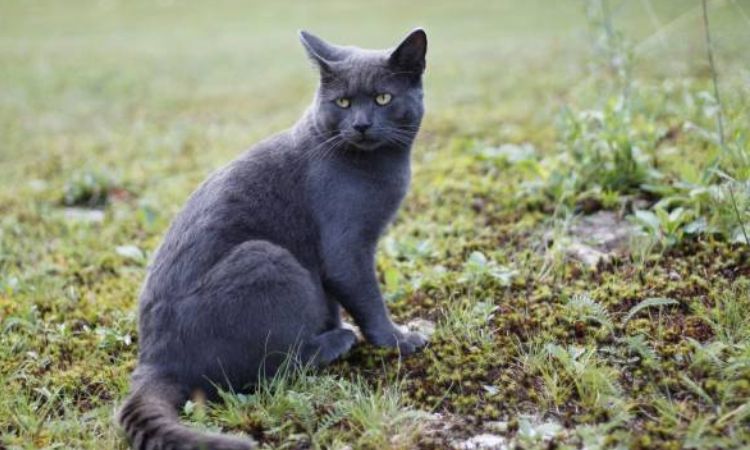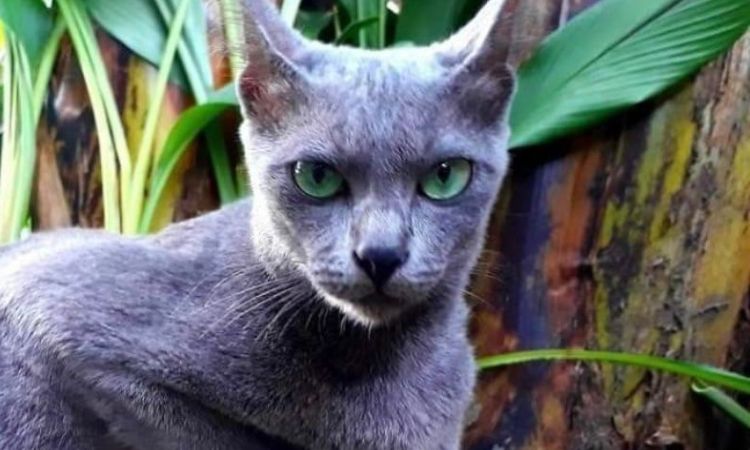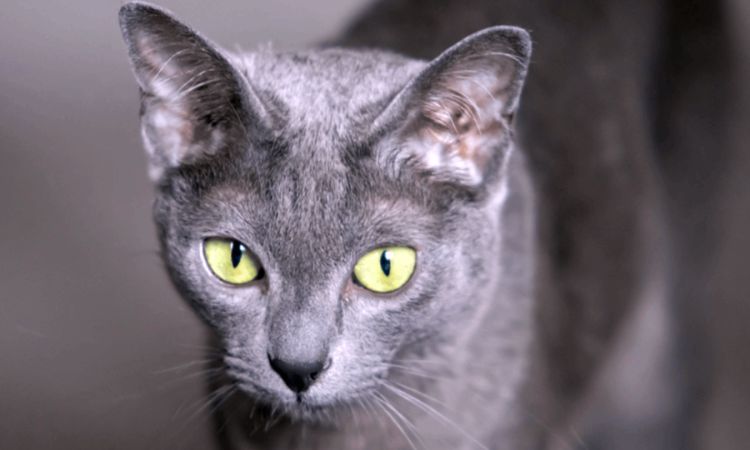Hidden away on the quiet island of Raas in Indonesia, the Raas cat or Busok cat stands as one of the world’s rarest and most mysterious feline breeds.
With its sleek coat, striking green eyes, and distinctively bent tail, this native cat has long captured the hearts of locals and intrigued cat lovers around the globe. Protected by island tradition and valued for its purity, the Raas cat isn’t just a pet—it’s a living piece of Indonesian history.

History and Origin of the Indonesian Native Breed
The Raas cat is a truly native Indonesian breed, believed to have evolved naturally on Raas Island, a small island off the coast of Madura. Its origins are shrouded in mystery, as there are no definitive records of how the breed first appeared. What is clear, however, is that the breed developed in isolation, which has helped maintain its pure bloodline and unique characteristics over centuries.
Local legends and traditions play a significant role in the breed’s history. According to folklore, Raas cats possess a “sixth sense” and are considered sacred, traditionally owned only by community leaders, nobles, and religious figures (ulemas). It was widely believed that removing a Raas cat from the island would bring misfortune, a superstition that helped preserve the breed’s purity by discouraging trade or relocation.
Due to this geographic isolation and cultural reverence, the Raas cat has maintained high genetic diversity despite its small population. Until recently, the breed was virtually unknown outside of its native island, with only a few cats making their way to nearby cities such as Bandung, Bogor, and Semarang.
In modern times, efforts have been made to conserve and promote the Raas cat, leading to its recognition by the World Cat Federation (WCF) in 2022 as a native Indonesian breed. This recognition not only honors the breed’s unique heritage but also helps raise awareness about its rarity and the importance of preserving this living symbol of Indonesian culture.
The Raas cat’s history is therefore a combination of natural evolution, cultural preservation, and careful human stewardship, making it one of the most fascinating and historically significant domestic cat breeds in the world.
Physical Characteristics: Appearance of the Busok Cat
The Busok cat, also known as the Raas cat, boasts a striking and graceful appearance, making it one of the most unique and exotic cat breeds in the world. With a muscular yet elegant build, it is often compared to leopards and jungle cats, exuding a wild yet refined presence.
Size and Build
- Size: Medium-to-Large
- Build: Muscular, with a graceful and sleek appearance
- Comparison: Resembling the powerful yet lithe frame of a leopard or jungle cat, the Busok cat is larger than many other domestic cat breeds, yet retains an elegance typical of wild felines.
This breed is well-muscled, lending it a strong presence without sacrificing its agility or grace. The Busok cat is built for both strength and movement, with its sturdy body allowing it to climb, jump, and explore its environment with ease.
Head and Facial Features
- Face Shape: Triangular and slightly square, creating a sharp and distinct look
- Chin: Slightly pointed, giving the face a refined yet angular appearance
The Busok cat’s face is marked by a unique triangular shape that transitions to a slightly square outline, distinguishing it from other breeds. Its sharp chin adds to the strong lines of the face, complementing its muscular body and lending it an assertive yet noble expression.
- Ears: Long, pointed, and upright
The Busok cat’s ears are another striking feature. They stand upright, extending high above the head with a pointed shape, adding to its wild, jungle cat look. These ears give the breed excellent hearing, a trait useful for their hunting instincts. - Eyes: Striking green or amber
The eyes of the Busok cat are a vivid green or occasionally amber in color, with an oval shape. They are typically set wide apart, contributing to the breed’s intense and captivating gaze, which is both alert and mysterious.
Coat and Color Variations
- Coat Type: Short, dense, and sleek
The Busok cat has a short and sleek coat, which feels soft to the touch. Its fur is dense and luxurious, offering a shiny and well-maintained appearance that requires minimal grooming. - The Busok Color: Prized bluish-gray hue
The most recognizable and highly prized color variation of the Busok cat is its blue (or bluish-gray) fur. This striking shade is often the defining characteristic for Busok cats and is sought after for its unique, almost ethereal appearance. The blue color is often found in solid or two-tone patterns, with white on the chest and belly. - The Amethyst Color: Rare cinnamon/dark brown
The Amethyst color, found in the Raas cat, is an exceptionally rare variation of the breed. This color is a dark cinnamon or brown hue, often described as warm and deep, with a rich, reddish undertone. It is classified as a recessive color, which makes it even rarer and more coveted among enthusiasts. - Other Colors: Black, lilac, and chocolate
In addition to the traditional blue and cinnamon hues, new variations have begun to emerge, including black, lilac, and chocolate. These new shades further diversify the Busok cat’s appearance, enhancing its allure and expanding its potential appeal.
The Signature Trait: The Bent Tail Tip
One of the most distinctive features of the Busok cat is its bent tail tip, which is commonly found in many Asian breeds. This signature trait not only enhances the cat’s wild appearance but also gives it a unique and eye-catching silhouette. The tail is typically long and flexible, with the final tip curved slightly upward, adding an element of distinctiveness that makes this breed instantly recognizable.
The bent tail tip is believed to be a characteristic that ties the Busok cat to its Asian heritage, as many Asian breeds share this trait. It’s an attribute that adds to the elegance and mystique of the breed, as well as further solidifying its connection to wild cats from tropical regions.

Temperament and Personality of the Raas Cat
Overall Personality
The Raas cat is a fascinating breed known for its intelligence, high energy, and strong-willed personality. It possesses a natural independence that is characteristic of its wild ancestors, making it a confident and sometimes stubborn feline. Despite its initial aloofness, the Raas cat can also be incredibly loyal and affectionate once it forms a bond with its owner.
While these cats are intelligent, they are also mischievous, often testing boundaries and seeking out challenges. Their pragmatic and independent nature means they are not always easy to train, but with patience and consistent positive reinforcement, they can thrive as beloved companions.
Energy and Play Needs
Raas cats have an exuberant energy level and require ample physical and mental stimulation. They are highly active and curious, always seeking opportunities for exploration, climbing, and playing. Given their hunting background, these cats enjoy engaging in activities that mimic the chase and hunt behavior.
Providing them with interactive toys, puzzle feeders, and cat trees is essential to meet their mental and physical exercise needs. Without enough stimulation, they may become bored, potentially leading to destructive behaviors. Raas cats require plenty of space to move around and explore, and ideally, a home that provides them with areas to climb and jump freely.
Sociability and Relationship with Owners
- Initial Shyness and Suspicion of Strangers:
Raas cats are naturally reserved and cautious around new people and environments. Due to their wild origins, they tend to be suspicious of unfamiliar faces and may take time to warm up to new people. This initial shyness should not be mistaken for aloofness, as Raas cats are simply assessing their surroundings and the intentions of new individuals. - Forming a Bond (Affectionate and Loyal to Trusted Owners):
Once a Raas cat feels safe and secure in its environment, it can develop an incredibly strong bond with its owner. These cats are known to be loyal, and once trust is established, they can become affectionate, often seeking out their owners for cuddles or playtime. Their loyalty is unwavering, and they often form deep connections with the people who care for them. While they may still be wary of strangers, they are protective and loving towards their trusted human companions.
Suitability for Families and Other Pets
- Generally Recommended for Experienced or Single Owners:
Due to the primitive nature and strong-willed personality of the Raas cat, it is best suited for experienced cat owners or those who live alone. These cats require a significant amount of patience, consistency, and training. First-time cat owners may find the Raas cat’s independent attitude and initial shyness challenging to handle. - Caution with Young Children:
While Raas cats can form strong relationships with their human family members, they are generally not ideal for families with young children. Their nervousness around new people and noise sensitivity means that young children, who may not always understand boundaries, could inadvertently stress or overwhelm the cat. Older children who can respect the Raas cat’s space and needs are more likely to have positive interactions with this breed. - Instincts and Compatibility with Other Pets:
Given their hunting origins, Raas cats have a strong prey drive and may not get along well with smaller pets like birds, hamsters, guinea pigs, or other small animals. They may view these smaller creatures as potential prey. However, with proper socialization and a slow introduction, they can live peacefully with other cats and dogs, especially if the other animals are calm and well-behaved. It is important to ensure that their environment is structured to give them enough personal space to feel secure.
In conclusion, the Raas cat is an intelligent, energetic, and affectionate breed that requires an experienced owner who understands its independent nature and strong-willed personality. While they may be cautious and reserved with strangers, they are deeply loyal to those who earn their trust. Their high energy levels and hunting instincts make them best suited for homes that can provide mental stimulation, physical exercise, and a quiet, structured environment to meet their needs.
Care Guide for the Rare Raas Breed
1. Diet & Nutrition: Fuel for Their High Energy
Raas cats are high-energy and large-breed cats that require a nutrient-dense, high-protein diet to support their energetic lifestyle. Here’s how to meet their nutritional needs:
- Kittens: During their growth phase, Raas kittens need more food to support their rapid development. Ensure they have access to a high-protein kitten food formula designed for large breeds.
- Adults: As adults, Raas cats need a protein-rich diet to keep up with their high activity levels. Foods with real animal protein as the first ingredient are ideal. Look for high-quality commercial cat food designed for active or large breeds.
- Hydration: Fresh water should always be available, as Raas cats tend to get thirsty after their bouts of energetic play.
Tip: Avoid overfeeding and ensure you provide the proper portion sizes to maintain a healthy weight for your Raas cat.
2. Exercise Needs: Keeping Them Active and Engaged
Raas cats are incredibly energetic and require ample physical stimulation to remain happy and healthy. They are best suited to environments where they have plenty of space to explore and play.
- Toys and Enrichment: Provide interactive toys, puzzle feeders, and cat trees to engage your Raas cat mentally and physically. Automated toys that move on their own can also help burn energy when you’re away.
- Climbing and Scratching: Ensure there are scratching posts and climbing structures to allow them to satisfy their natural instincts and keep their claws healthy.
- Exploration: Raas cats are naturally curious and love to explore their surroundings. If possible, safe outdoor access or enclosed cat patios (catios) provide a stimulating environment for them to thrive.
Tip: Without sufficient exercise and mental stimulation, Raas cats can become bored and destructive.
3. Grooming: Low-Maintenance Care
Raas cats have a short, sleek coat that requires minimal grooming compared to long-haired breeds. However, regular grooming will still help maintain their health and comfort.
- Brushing: Although they don’t require frequent brushing, weekly brushing helps keep shedding under control and prevents matting.
- Nail Care: Regularly trim their nails to prevent them from becoming overgrown and difficult to manage. Start trimming when they’re young to help them get used to the process.
- Ear & Eye Care: Check their ears for wax build-up and clean them as needed. Use a soft, damp cloth to wipe away any dirt from their eyes.
Tip: Train your Raas cat to sit still for grooming from an early age, so the process becomes easier as they grow older.
4. Training & Socialization: Patience is Key
Raas cats are known for their independent and sometimes stubborn nature. While they are highly intelligent, they are not naturally inclined to please humans the way some dog breeds are. Here’s how to handle training and socialization:
- Socialization: Start socializing your Raas cat early, especially if you plan to introduce them to new people or other pets. Their natural wariness can make them cautious around strangers, so slow introductions are crucial.
- Obedience Training: While Raas cats can learn tricks and commands, consistency and positive reinforcement are necessary. Use treats and rewards to encourage good behavior.
- Litter Training: Start litter training as soon as possible, as Raas cats may not instinctively know where to go like other domesticated cats. Use a clean litter box and keep it in a consistent location.
- Managing Stubbornness: Due to their independent nature, Raas cats may challenge your authority. Stay patient and consistent with training to reinforce boundaries and rules.
Tip: Remember, Raas cats are not as eager to please as some other breeds, so avoid harsh punishment and focus on positive reinforcement.
5. Health Care: Monitoring Their Well-Being
Raas cats are generally healthy, but like all breeds, they require regular vet visits to monitor their health and well-being.
- Routine Check-ups: Schedule annual or bi-annual vet visits to ensure your Raas cat is in optimal health. Regular exams will help catch any issues early, such as respiratory infections or urinary tract infections.
- Flea, Tick, and Heartworm Prevention: If your Raas cat spends time outdoors, make sure to keep them on a flea and tick preventative and heartworm medication to protect them from parasites.
- Vaccinations: Ensure your Raas cat is up to date on their vaccinations, particularly if they venture outside. Talk to your vet about a tailored vaccination schedule based on your cat’s lifestyle.
- Genetic Concerns: As a relatively new breed, Raas cats may have some genetic predispositions, but there is little documented information. Monitoring for common cat conditions like FLUTD (Feline Lower Urinary Tract Disease) is important.
Tip: Be proactive about parasite prevention and disease management, especially if your Raas cat enjoys outdoor activities.

6. Dealing with Behavior: Understanding Their Needs
Raas cats are a primitive breed with a strong hunting instinct. They may be wary of new people or environments, so patience is necessary to develop a trusting relationship. Here are some behavior tips:
- Bonding: Raas cats bond deeply with their trusted humans. While they may be shy or aloof at first, they can become incredibly affectionate once they feel safe and comfortable. Allow them to come to you on their terms.
- Caution with Children: Due to their nervousness around new people and sudden movements, Raas cats may not be ideal for households with young children. Older, more respectful children may be a better match.
- Hunting Instincts: Keep small pets (like birds or rodents) away from Raas cats, as they were bred to be hunting cats and may view small animals as prey.
Tip: Be sure to respect their boundaries and avoid forcing interactions. Let your Raas cat come to you when they’re ready.
The Raas cat is a captivating and unique breed, with its striking appearance and complex personality. While they can be challenging to care for due to their high energy and strong will, with the right owner, Raas cats can become deeply affectionate and loyal companions. Their rarity and fascinating heritage make them an intriguing choice for experienced cat owners. Whether you’re drawn to their beauty or their mysterious origins, owning a Raas cat is a rewarding experience for those ready to meet their specific needs.






